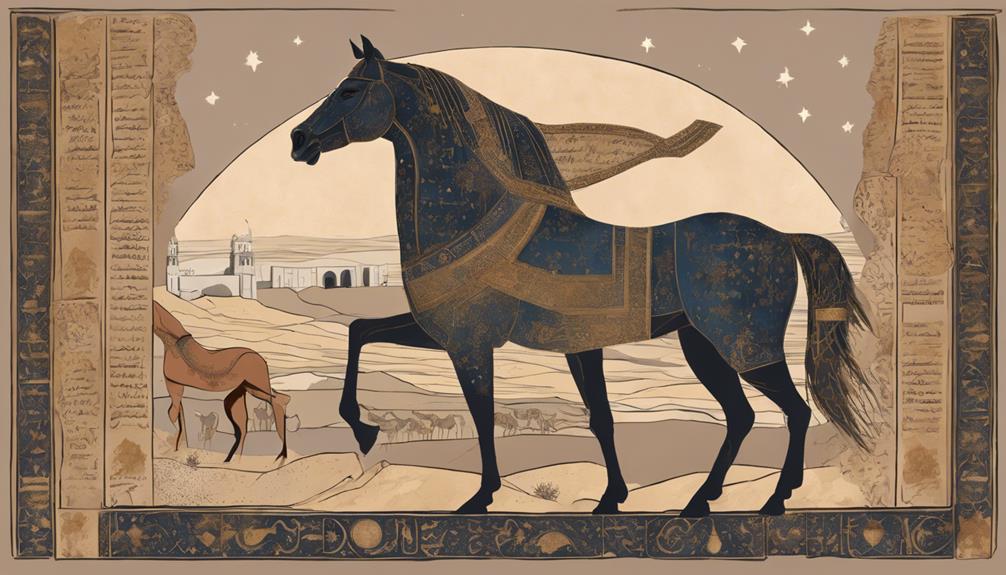As you explore the golden age of pre-Islamic Arabic verse, you'll discover a poetic landscape shaped by tribal rivalries, poetic patronage, and the vast expanse of the Arabian Desert. The revered Seven Fabled Poets of Al-Mu'allaqat, including Imru' al-Qais and Antara, celebrated chivalry, warrior ethos, and love in their verses. The qasida form, with its intricate tripartite structure, allowed poets to explore these themes in masterful ways. With each poem, you'll uncover more of the intricate tapestry that is Al-Mu'allaqat – and the secrets waiting to be unraveled in the verses that follow.
Origins of Pre-Islamic Arabic Poetry
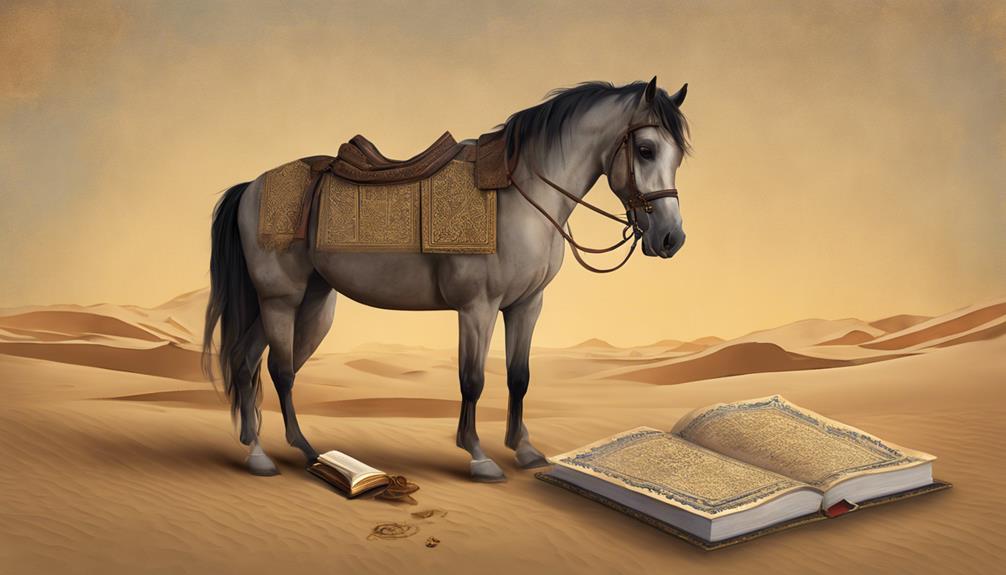
As you explore the world of pre-Islamic Arabic poetry, you'll discover that its origins can be traced back to the 5th century CE, when the Arabian Peninsula was a hotbed of tribal rivalries and poetic competitions. In this era, poetry served as a powerful tool for tribes to assert their dominance and prestige. Poets were highly valued for their ability to craft verses that extolled the virtues of their tribe, while denigrating rival clans. Tribal rivalries fueled the development of poetry, as each tribe sought to outdo its competitors in eloquence and artistry.
Poetic patronage played a significant role in this period, as wealthy patrons would sponsor poets to compose verses in their honor. In return, poets would receive financial support, protection, and social status. This patronage system allowed poets to focus on honing their craft, leading to a proliferation of poetic talent across the Arabian Peninsula. As a result, poetry became an essential component of pre-Islamic Arabian culture, with poets serving as the guardians of tribal history, mythology, and cultural heritage.
The Seven Fabled Poets of Al-Mu'allaqat
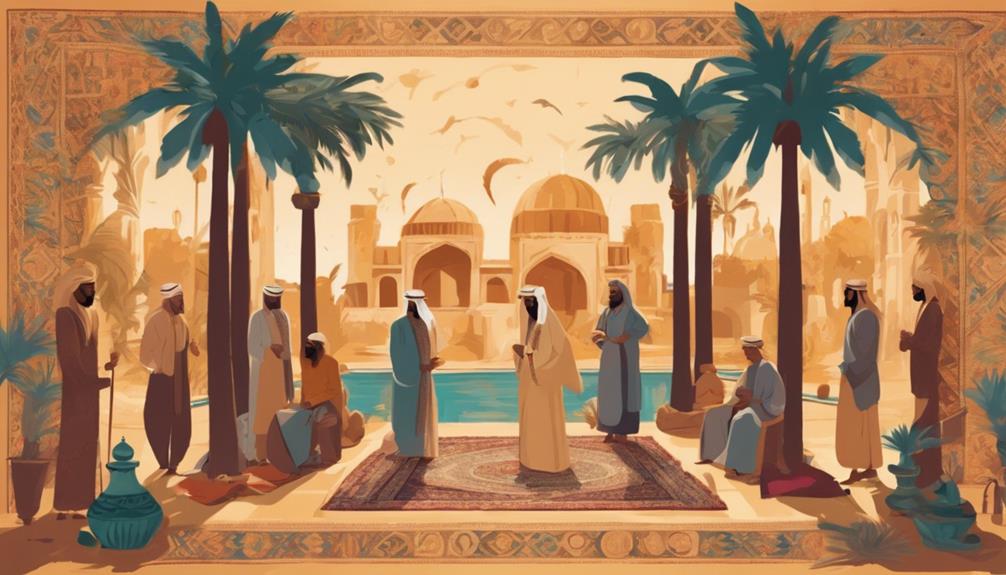
Among the most revered poets of pre-Islamic Arabia, you'll find the seven fabled poets of Al-Mu'allaqat, whose masterful verses have been painstakingly preserved and celebrated for centuries. These exceptional poets, including Imru' al-Qais, Tarafa, Zuhayr, Labid, Antara, Amr ibn Kulthum, and Harith, have left an indelible mark on Arabic literature. Their poetic rivalries, often fueled by tribal pride and personal ambition, pushed the boundaries of linguistic innovation and artistic expression. The cultural significance of these poets lies in their ability to capture the essence of pre-Islamic Arabian society, conveying the values, traditions, and emotions of a bygone era. Through their works, you'll explore a vibrant tapestry of Bedouin life, where honor, loyalty, and hospitality were paramount. As you immerse yourself in the world of Al-Mu'allaqat, you'll uncover the intricate web of poetic rivalries, cultural nuances, and artistic mastery that have made these poets legendary figures in Arabic literature.
Themes of Love and Chivalry
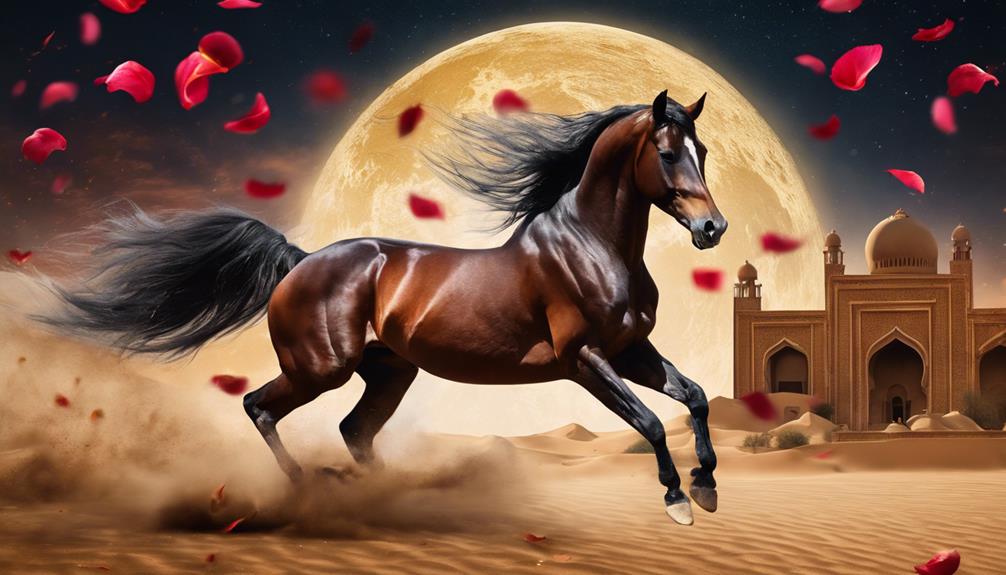
In the domain of Al-Mu'allaqat, you'll discover that the seven fabled poets explored intricate tapestries of love and chivalry, their verses pulsing with the rhythms of a bygone era, where honor, loyalty, and passion entwined like the delicate threads of a finely crafted Arabian carpet.
As you explore further into the poetry, you'll find that love is not just a romantic sentiment, but a reflection of the tribal rivalries that defined the Arabian Peninsula. The poets' verses often revolved around the warrior ethos, where bravery, loyalty, and generosity were the hallmarks of a noble character. The beloved, in this perspective, symbolized the unattainable, a fleeting dream that fueled the poet's creative endeavors.
Through their poetry, the seven fabled poets of Al-Mu'allaqat celebrated the virtues of chivalry, where the warrior's code of honor was paramount. In this world of tribal rivalries and shifting alliances, love and chivalry became intertwined, reflecting the complexities of a bygone era. As you immerse yourself in these ancient verses, you'll uncover the intricate web of emotions, honor, and loyalty that defined the golden age of Arabic poetry.
Desert Landscapes and Nomadic Life
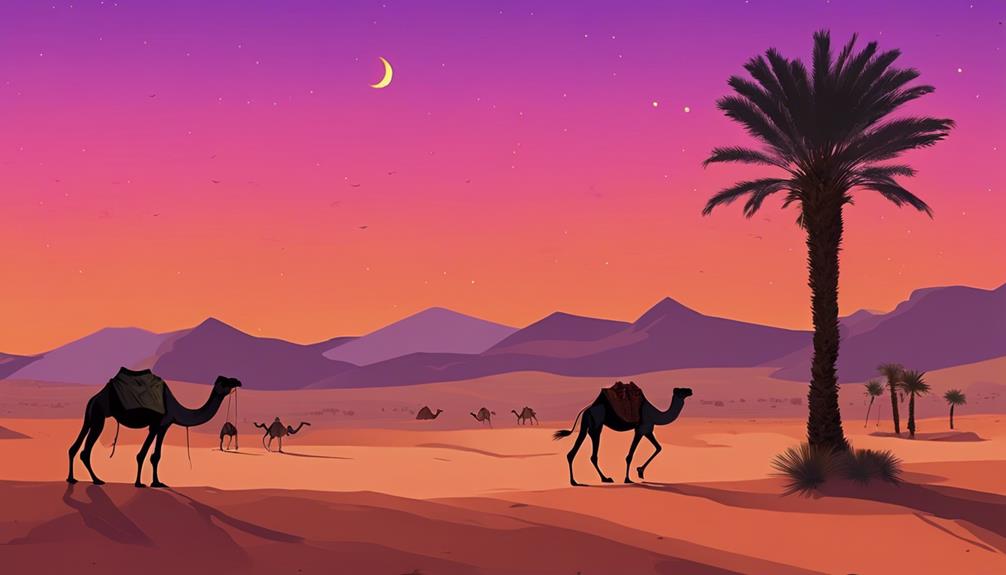
Few landscapes have inspired the human imagination like the Arabian Desert, where shifting dunes stretch towards the horizon, and you'll find the nomadic life of the Bedouin tribes woven intricately into the fabric of Al-Mu'allaqat poetry. As you explore the verses, you're transported to a world of desert caravans, where merchants and travelers traversed the endless dunes, sharing stories and news at tribal settlements. These mobile communities, bound by kinship and shared traditions, formed the backbone of pre-Islamic society.
The Al-Mu'allaqat poets masterfully evoked the harsh beauty of the desert, where the sun-scorched terrain and star-filled skies shaped the Bedouin character. You sense the rugged individualism, the importance of honor and hospitality, and the resilience that defined these desert dwellers. Through the poetry, you'll discover odes to the desert's majesty, where the poets conjure vivid images of mirages, oases, and sandstorms. In this world, the desert landscape is not just a backdrop, but a living, breathing entity that shapes the people and their stories. As you read on, you'll find yourself immersed in a world of endless expanses, where the rhythms of the desert have inspired some of the most sublime poetry in human history.
Poetic Forms and Metre
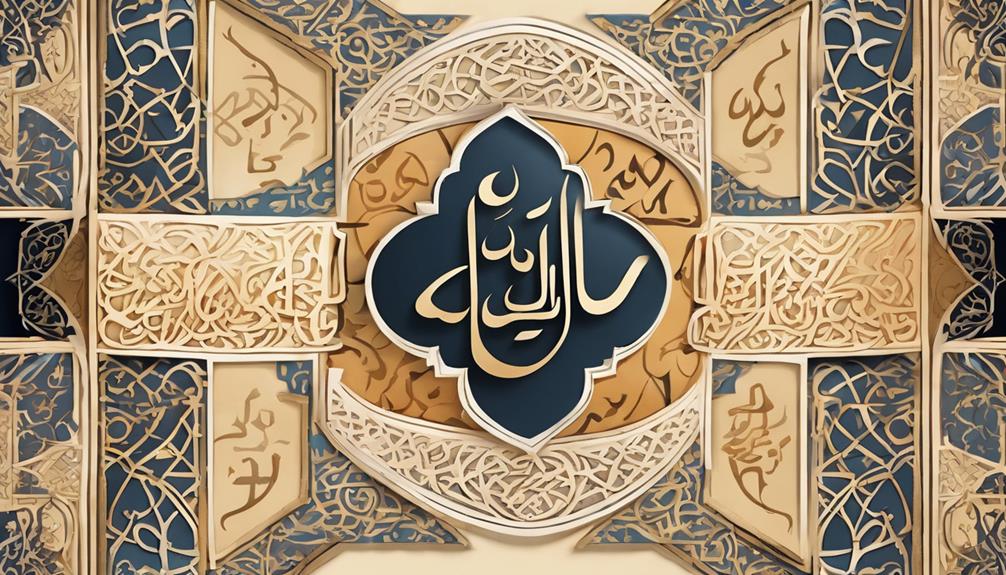
As you explore the realm of Al-Mu'allaqat poetry, you'll find that the poets' mastery of form and meter was as integral to their art as the desert landscape was to their lives. The Arabs' innate sense of rhythm and musicality is reflected in the intricate patterns of Arabic rhythms, which governed the poetic cadence of Al-Mu'allaqat. The meters, known as 'bahr,' were based on the natural flow of speech and the rhythms of everyday conversation. This attention to meter created a sense of musicality, making the poetry an aural experience as much as a written one.
The poets' use of meter was not merely decorative; it was an essential component of the poem's overall structure and meaning. By employing specific meters, poets could convey emotions, attitudes, and even moral lessons. The varied meters also allowed poets to experiment with different forms, from the elegiac to the celebratory. As you explore further into Al-Mu'allaqat, you'll find that the intricate dance of meter and rhythm is a hallmark of this remarkable poetry, imbuing the verses with a timeless beauty and musicality.
Influence of Pagan Arabia's Mythology
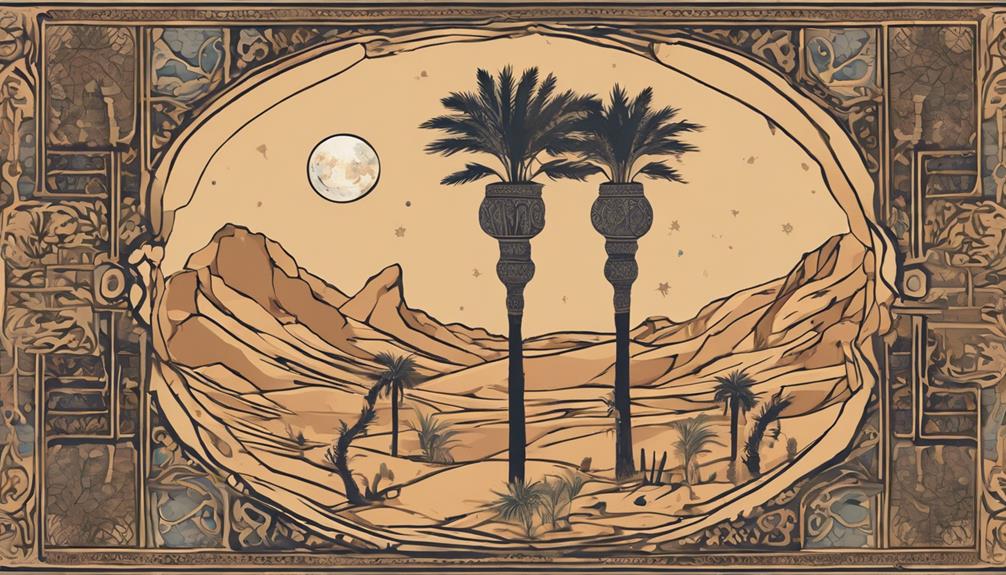
Beyond the domain of poetry, the mythological landscape of Pagan Arabia exerted a profound influence on the thematic and symbolic resonance of Al-Mu'allaqat, with its rich tapestry of gods, goddesses, and supernatural beings informing the poets' exploration of love, honor, and the human condition. As you explore the world of pre-Islamic poetry, you'll discover that the tribal deities of ancient Arabia played a significant role in shaping the poetic imagination. The pantheon of gods and goddesses, each associated with specific aspects of nature and human experience, provided a symbolic language that poets could draw upon to convey complex emotions and ideas.
The cosmic mythology of Pagan Arabia, with its intricate web of celestial and terrestrial forces, also had a profound impact on the poetic vision of Al-Mu'allaqat. The poets' ability to interweave mythological motifs and astronomical observations created a rich tapestry of imagery, imbuing their poetry with a sense of cosmic significance. By drawing upon this mythological heritage, the poets of Al-Mu'allaqat were able to craft a unique poetic idiom that continues to resonate with readers to this day.
The Role of the Qasida Form
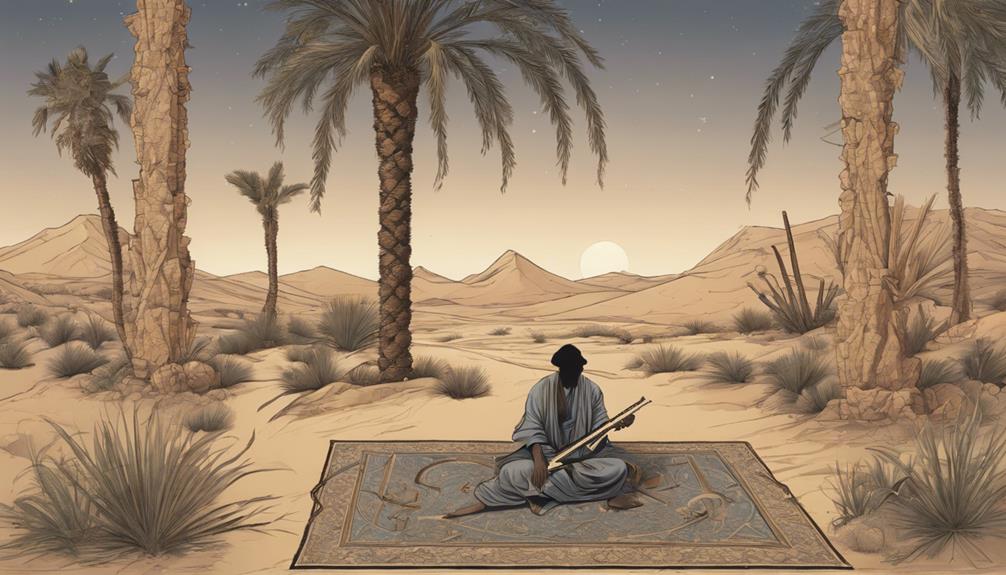
In the realm of pre-Islamic poetry, you'll notice that the qasida form, with its characteristic tripartite structure, served as a versatile canvas for poets to explore themes of love, tribe, and the human condition. This structure, comprising an introduction, a journey, and a conclusion, allowed poets to explore intricate narratives that showcased their mastery of Arabic lyricism. The qasida's flexibility enabled poets to address a wide range of subjects, from the majesty of the desert landscape to the intricacies of human emotion. As you explore the world of pre-Islamic poetry, you'll discover that the qasida form was an integral part of the poetic tradition, providing a framework for poets to express themselves with precision and nuance. The careful balance of the qasida structure, with its carefully crafted stanzas and rhyming patterns, created a sense of musicality that resonated with audiences. By examining the qasida form, you'll gain insight into the artistic genius of pre-Islamic poets, who used this versatile form to create works of enduring beauty and significance.
Arabic Language and Script Evolution
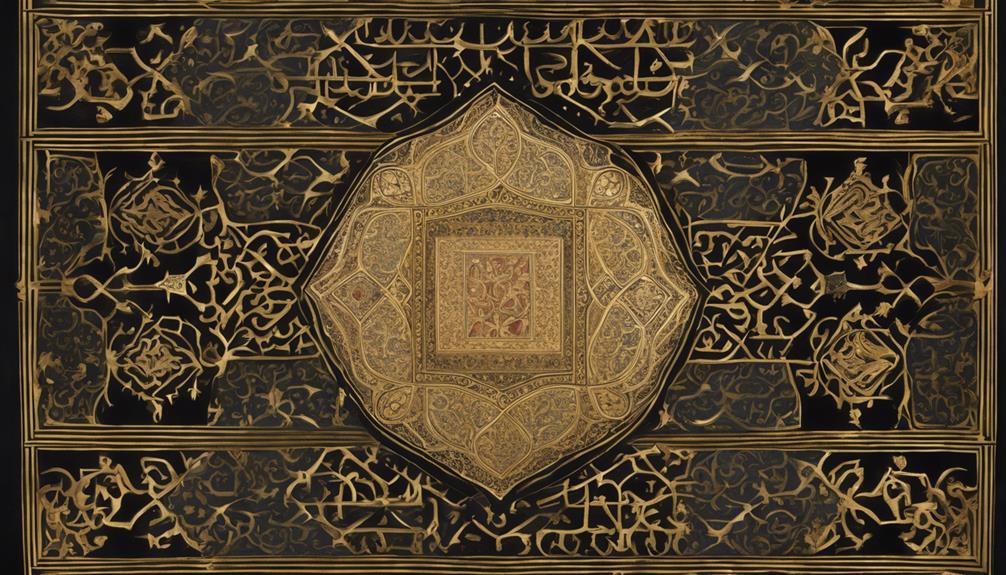
Delving into the intricacies of Arabic script evolution, you'll uncover a rich tapestry of influences, from ancient Nabataean inscriptions to the refined cursive styles of Islamic calligraphy. As you explore this evolution, you'll notice the significant impact of the Islamic conquests on the development of Arabic script. The need for a standardized script led to the refinement of the cursive styles, giving rise to the majestic and expressive calligraphy that has come to define Arabic art. The calligraphy evolution was marked by the introduction of diacritical marks, which enabled the precise representation of Arabic phonetics. This standardization of script played a vital role in the spread of literacy and Islamic knowledge. The refinement of Arabic script also facilitated the preservation and transmission of Arabic poetry, allowing masterpieces like Al-Mu'allaqat to be passed down through generations. Through the meticulous study of Arabic script evolution, you'll gain a deeper appreciation for the intricate relationship between language, art, and culture in the Arab world.
Legacy of Al-Mu'allaqat Today

As you've witnessed the profound impact of Arabic script evolution on the preservation of masterpieces like Al-Mu'allaqat, you may wonder how this revered collection of poems continues to shape the literary landscape of the Arab world today. The answer lies in its enduring cultural significance, which permeates every aspect of Arabic literature. Al-Mu'allaqat's influence can be seen in the works of modern Arab poets, who continue to draw inspiration from its rich imagery and nuanced exploration of the human experience. The collection's contemporary relevance is evident in its ability to evoke powerful emotions and spark introspection, making it a timeless classic that transcends generations. Moreover, Al-Mu'allaqat's exploration of themes such as love, nature, and the human condition continues to resonate with readers today, solidifying its position as a cornerstone of Arabic literature. As a result, the legacy of Al-Mu'allaqat continues to inspire and influence literary works, ensuring its cultural significance remains unwavering in the modern era.
Frequently Asked Questions
What Is the Significance of the Mu'allaqat in Arabic Literary History?
You recognize the Mu'allaqat's significance in Arabic literary history as a cornerstone of literary canonization, where carefully curated poems were preserved to reflect the cultural ethos of the time. This anthology's cultural preservation is remarkable, as it captures the essence of pre-Islamic Arabia, conveying the values, traditions, and aesthetics of a bygone era.
Were Women Allowed to Compose Poetry in Pre-Islamic Arabia?
You find yourself in a patriarchal society, where women's roles are limited. Yet, surprisingly, women did compose poetry in pre-Islamic Arabia. Female bards, known as sha'irat, played a significant role in oral traditions. They'd recite poems at gatherings, often using their art to critique societal norms. Their voices, though often marginalized, contributed to the rich literary heritage of the time, challenging the dominant patriarchal structures that sought to silence them.
How Did the Bedouin Lifestyle Influence Arabic Poetry Themes?
As you venture into the domain of Arabic poetry, imagine the vast, arid expanse of the desert landscape, where tribal loyalty was the lifeblood of survival. In this unforgiving environment, the Bedouin lifestyle shaped the themes of Arabic poetry. You'll find that the nomadic existence, with its harsh climate and tribal feuds, influenced poets to write about honor, hospitality, and the fleeting nature of life. The desert's harsh beauty also inspired odes to the natural world, where the majestic camel and the star-filled night sky became symbols of resilience and freedom.
Can Non-Arabic Speakers Appreciate Arabic Poetry's Nuances?
As you explore Arabic poetry, you'll encounter cultural barriers and linguistic complexities that can obscure its nuances. Without a deep understanding of the language, you may struggle to appreciate the intricate wordplay, metaphors, and allusions that underpin the poetry's richness. However, with careful translation and interpretation, you can still grasp the essence of the poetry, even if the full depth of meaning remains elusive.
Are There Any Surviving Original Manuscripts of Al-Mu'allaqat Poems?
You're likely familiar with the ancient Library of Alexandria, where scribes meticulously copied manuscripts, often reusing parchments. This practice, known as palimpsest analysis, reveals hidden texts, but raises questions about manuscript authenticity. When it comes to Al-Mu'allaqat poems, few original manuscripts survive, and those that do are often fragmented or copied onto reused parchments. Scholars must employ rigorous analysis to verify authenticity, ensuring the poems' nuances are preserved.
